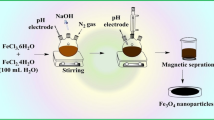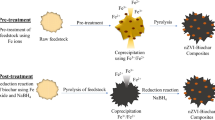Abstract
Natural geochemical processes and anthropogenic activities produce selenium (Se)-containing wastewater, in which selenium is present as selenous acid (Se(IV)) and selenic acid (Se(VI)). Herein, we evaluated the Se removal performances of magnesium oxide (MgO) with different crystallinities at pH 10.5. Normal MgO and low-crystalline (LC-MgO) were reacted in 1, 2, and 5 mg dm−3 Se(IV) or Se(VI) solution for 120 min. The Se concentrations of both the species did not apparently decrease in the normal MgO systems. However, >90% of Se(IV) was successfully removed by LC-MgO within 5 min under all conditions. X-ray diffraction (XRD) analysis indicated that Se(IV) was removed via surface complexation on Mg(OH)2 formed by the rapid hydration of LC-MgO. The enhancement of Se removability of the LC-MgO system was explained by the rapid hydration of the higher surface area of LC-MgO when compared with that of normal MgO. Majority of the Se(VI) (60–80%) was removed by LC-MgO during the first 20 min; however, it was gradually released back into the solution over time. During hydration, the changing XRD peak patterns and zeta potential of LC-MgO indicated that the increased charge density obtained by the accumulation of Mg2+ released via MgO dissolution would cause the temporal uptake of Se(VI) in the interlayer of Mg(OH)2. Subsequently, the charge density decreased with the hydration of Mg2+, indicating that Se(VI) was redissolved. Therefore, LC-MgO is a promising material for treating Se-containing alkaline wastewater. However, short-time operation and low concentration (<1 mg dm−3) must be ensured for successful Se(VI) removal.




Similar content being viewed by others
Data Availability
The datasets supporting the conclusions of this article are included within the article and in the additional files submitted.
References
Boisson, F., Gnassia-Barelli, M., & Romeo, M. (1995). Toxicity and accumulation of selenite and selenate in the unicellular marine alga Cricosphaera elongate. Archives of Environmental Contamination and Toxicology Volume, 28, 487–493.
Chapman, P. M., Adams, W. J., Brooks, M. L., Delos, C. G., Luoma, S. N., Maher, W. A., Ohlendorf, H. M., Presser, T. S., & Shaw, D. P. (2010). Ecological assessment of selenium in the aquatic environment: Summary of a SETAC Pellston Workshop. Florida, Society of Environmental Toxicology and Chemistry, 978–1–4398-2677-5.
Das, S., Hendry, J. M., & Essilfie-Dughan, J. (2013). Adsorption of selenate onto ferrihydrite, goethite, and lepidocrocite under neutral pH conditions. Applied Geochemistry, 28, 185–193.
Fukuda, H., Tsuchiya, K., Toba, Y., Eguchi, M., & Tokoro, C. (2020). Rapid boron removal from wastewater using low-crystalline magnesium oxide. Journal of Environmental Chemical Engineering, 8, 104171.
Fukushi, K., Miyashita, S., Kasama, T., Takahashi, Y., & Morodome, S. (2018). Superior removal of selenite by periclase during transformation to brucite under high-pH conditions. Journal of Hazardous Materials, 371, 370–380.
García-Soto, F. M. M., & Camacho, M. E. (2006). Boron removal by means of adsorption with magnesium oxide. Separation and Purification Technology, 48, 36–44.
Gonzalez, C. M., Hernandez, J., Parsons, J. G., & Gardea-Torresdey, J. L. (2011). Adsorption of selenite and selenate by a high- and low-pressure agedmanganese oxide nanomaterial. Instrumentation Science and Technology, 39, 1–19.
Hageman, P. W. S., Weijden, R. D., Weijma, J., & Buisman, J. N. C. (2013). Microbiological selenate to selenite conversion for selenium removal. Water Research, 47, 2118–2128.
Harada, T., & Takahashi, Y. (2008). Origin of the difference in the distribution behavior of tellurium and selenium in a soil-water system. Geochimica et Cosmochimica Acta, 72, 1281–1294.
Hayes, K. F., Roe, A. L., Brown Jr., G. A., Hodgson, K. O., Leckie, J. O., & Parks, G. A. (1987). In situ X-ray absorption study of surface complexes: Selenium oxyanions on a-FeOOH. Science, 238, 783–786.
König, S., Luguet, A., Lorand, J.-P., Wombacher, F., & Lissner, M. (2012). Selenium and tellurium systematics of the Earth’s mantle from high precision analyses of ultra-depleted orogenic peridotites. Geochimica et Cosmochimica Acta, 86, 354–366.
Martinez, M., Gimenez, J., de Pablo, J., Rovira, M., & Duro, L. (2006). Sorption of selenium (IV) and selenium (VI) onto magnetite. Applied Surface Science, 252, 3767–3773.
Muscatello, J. R., & Janz, D. M. (2009). Selenium accumulation in aquatic biota downstream of a uranium mining and milling operation. Science of the Total Environment, 407, 1318–1325.
Sasaki, K., Fukumoto, N., Moriyama, S., & Hirajima, T. (2011). Sorption characteristics of fluoride on to magnesium oxide-rich phases calcined at different temperatures. Journal of Hazardous Materials, 191, 240–248.
Tan, C. L., Nancharaiah, V. Y., van Hullebuschc, D. E., & Lens, N. L. P. (2016). Selenium: Environmental significance, pollution, and biological treatment technologies. Biotechnology Advances, 34, 886–907.
Tokoro, C., Yatsugi, Y., Sasaki, H., & Owada, S. (2008). Quantitative modeling of co-precipitation phenomena in wastewater containing dilute anions with ferrihydrite using a surface complexation model. Resources Processing, 55, 3–8.
United States Environmental Protection Agency. (2014). External peer review draft — Aquatic life ambientwater quality criterion for selenium — Freshwater 2014. United States Environmental Protection Agency (EPA-820-F-14-005)
Wang, J., Wang, T., & Burken, G. J. (2007). The leaching characteristics of selenium from coal fly ashes. Journal of Environmental Quality, 36, 1784–1792.
World Health Organization. (2011). Guidelines for drinking-water quality: Selenium in drinking-water. Switzerland: WHO Press.
Yoshida, T., Igarashi, T., Asakura, K., Miyamae, H., Iyatomi, N., & Hashimoto, K. (2004). Ferrite formation using precipitates neutralized by magnesium oxide in the treatment of acid mine drainage. Journal of MMIJ, 120, 577–583.
Zelmanov, G., & Semiat, R. (2013). Selenium removal from water and its recovery using iron (Fe3+) oxide/hydroxide-based nanoparticles sol (NanoFe) as an adsorbent. Separation and Purification Technology, 103, 167–172.
Zhang, N., Lin, L. S., & Gang, D. C. (2008). Adsorptive selenite removal from water using ironcoated GAC adsorbents. Water Research, 42, 3809–3816.
Acknowledgements
We appreciate the cooperation of Organo Corporation in this study. Part of this work was conducted at the Waseda Research Institute for Science and Engineering and Research Organization for Open Innovation Strategy, Waseda University.
Code Availability
Not applicable.
Author information
Authors and Affiliations
Corresponding author
Ethics declarations
Competing Interests
The authors declare no competing interests.
Additional information
Publisher’s Note
Springer Nature remains neutral with regard to jurisdictional claims in published maps and institutional affiliations.
Rights and permissions
About this article
Cite this article
Fuchida, S., Tsuchiya, K. & Tokoro, C. Selenite and Selenate Adsorption on Low-Crystalline Magnesium Oxide Under Alkaline Conditions. Water Air Soil Pollut 232, 160 (2021). https://doi.org/10.1007/s11270-021-05127-x
Received:
Accepted:
Published:
DOI: https://doi.org/10.1007/s11270-021-05127-x




